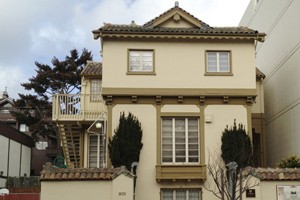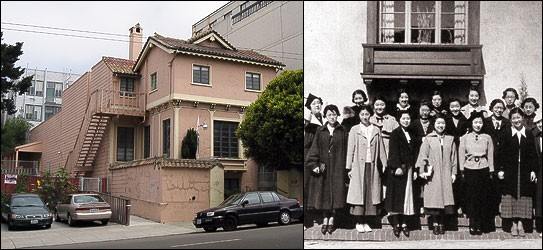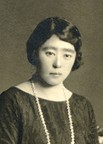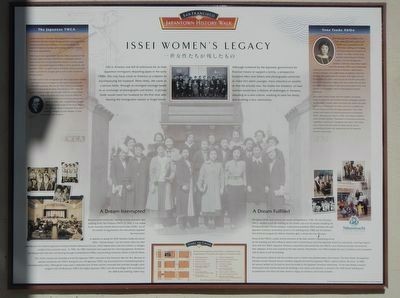Former Japanese YWCA of San Francisco: Issei Women's Legacy
Introduction
Text-to-speech Audio
Images
San Francisco Japantown's YWCA (image from San Francisco Planning)

San Francisco Japantown's YWCA, then and now (image from California Japantowns)

Yona Tsudo Abiko, founder of the San Francisco Japanese YWCA (image from Discover Nikkei)

Issei Women's Legacy marker (image from the Historic Markers Database)

Backstory and Context
Text-to-speech Audio
San Francisco's first Japanese immigrants (or Issei) arrived in the early 1860s, settling primarily in Chinatown and South Park. Meanwhile, in the 1870s, the Western Addition (including the land that would become Japantown, or Nihonmachi) subdivision was being transformed from a sandy, chaparral habitat for bobcats, rabbits, and quail, into a Victorian neighborhood. When the earthquake and subsequent fire of 1906 drove many San Franciscans out of their homes, tent villages in the Western Addition's parks provided temporary shelter for many of the city's residents, including much of the Japanese population. Roughly one square mile of the Western Addition became, at this time, San Francisco's Japantown, with the emergence of Japanese churches, shrines, shops, and restaurants.
In the early 20th century, Japanese immigrants faced the challenges of adapting to a new culture, building a new community, finding work and housing for their families, and racial discrimination. As if these challenges were not enough, many Issei women came to America as "picture brides," brought into marriages arranged via photographs and letters, to husbands whom they would not meet until clearing the Angel Island immigration station. More and more young Japanese women struggled to find work and housing, but the Japanese were excluded from the benefits of established organizations through segregation policies.
In 1912, a group of Issei women from local Japanese Christian churches created Joshi Seinen Kai, a boarding house for young Japanese women which also offered classes on the English language, American-style cooking, and sewing. The most prominet leader of this effort was Yonako Tsuda Abiko (1880-1944), who was born shortly after the end of the Japanese feudal era to a Samurai father. Her father, Sen Tsuda, studied English and Dutch, working as a government interpreter on a mission to the United States in 1867. He and his wife, Hatsuko, were the first Japanese Methodists. Yonako's sister, Umeko, established a private women's boarding school on the East Coast of the U.S. with the assistance of Quaker women. When Yonako spent a year traveling with Umeko in 1907, the sisters were welcomed to the White House by President Theodore Roosevelt. Despite anti-Japanese sentiment and racial discrimination on the West Coast, Yonako emigrated in order to marry a California Issei named Kyutaro Abiko, the founder of Nichibei Shimbun, a Japanese language San Francisco newspaper. The couple married in Tokyo in February of 1909 and returned to San Francisco that summer. Yona was quick to become involved in Church and community life, and accomplished many important educational, diplomatic, and service goals in her lifetime. She advocated the building of "bridges of understanding" [3] between the United States and Japan.
The "Ladies' Agreement" between the governments of Japan and the United States in the 1920s prohibited picture bride immigrations, and the Issei women's organization turned their attention to the Nisei generation (persons born in the United States or Canada to Japanese-born parents). Yona Tsuda Abiko became involved with the San Francisco Young Women's Christian Association (YWCA). However, segregation policies excluded the Japanese from the full benefits of the YWCA, so the Issei women decided to form an independent Japanese YWCA (JYWCA). The 1913 Alien Land Law prevented the direct purchase of property for this purpose, but in 1921, after an extensive fund-raising campaign in the Japanese community, the San Francisco YWCA agreed to hold the property at 1830 Sutter Street in trust for the JYWCA. In addition to helping young women by providing housing and skills training, the JYWCA also served as a social, cultural, and athletic center. Despite the Great Depression, the Issei women were able to raise enough funds by the early 1930s to commission a new building. Architect Julia Morgan designed the structure which still stands at 1830 Sutter Street, providing her services pro bono. Morgan's design included a dormitory, meeting rooms, offices, a kitchen, and an auditorium with the only genuine Noh theater stage in the western United States, as well as a tokonoma, an alcove attached to the stage for the performance of tea ceremonies. Classes offered at the JYWCA included Japanese flower arrangement, American and British law, swimming, fashion, economics, art, interior design, and music.
During the Second World War, the internment of Japanese Americans (and other Asian Americans) in camps led to the removal of the Issei women who had founded the JYWCA from San Francisco. The San Francisco YWCA leased the building to the American Friends Service Committee (AFSC), an organization actively opposed to the Internment, as the "Friends House." The Friends House assisted interned students attend colleges outside the exclusion zone during the war, and served as temporary housing for returning Japanese San Franciscans after the war. However, most of the women who had established the JYWCA settled in other cities after the war, and the independence of the JYWCA ended and nearly forgotten altogether.
By 1985, the JYWCA building's only tie to the Japanese American community was the Nihonmachi Little Friends (NLF), a non-profit organization for preschool through elementary school age children. NLF had been established ten years earlier as an affordable, educational, multicultural, and Japanese/English bilingual childcare service. Along with the Harrison Out of School Program for African American girls, an organization housed in the building since at least 1966, the NLF was threatened with eviction when the San Francisco YWCA decided to sell the former JYWCA building. Community activists and academic researchers, along with the Soko Bukai organization of Japanese Christian Churches, fought the evictions and the sale, eventually settling out of court in 2002 in favor of the Japanese American community. Ownership and stewardship of the building officially passed to the NLF organization.
Marker Inscription:
Issei
Women's Legacy
San Francisco Japantown History Walk
Life in
America was full of unknowns for an Issei (Japanese immigrant) departing Japan
in the early l900s. She may have come to America as a laborer or accompanying
her husband. More likely, she came as a picture bride through an arranged
marriage based on an exchange of photographs and letters. A picture bride would
meet her husband for the first time after clearing the immigration station at
Angel Island. / Although screened by the Japanese government for financial
means to support a family, a prospective husband often sent letters and
photographs contrived to make him seem younger, more attractive or wealthier
than he actually was. No matter her situation, an Issei woman would face a
lifetime of challenges in America: adapting to a new culture, working to raise
her family and building a new community.
The Japanese YWCA (top left)
As San Francisco's Nihonjin Machi (Japanese Town) became established, the Issei
women recognized that a growing number of young women were seeking temporary
housing, skills training, cultural continuity and social opportunities. / Admiring
service organizations like the YWCA, but barred from full participation and use
of the facilities by segregation policies, Issei women from the local Japanese
Christian churches established an independent Japanese YWCA in 1912. / Eventually,
the Japanese YWCA's programs grew to include cultural, social and athletic
activities for younger girls as well as their service for young women. / The
Issei women soon recognized that their organization needed a permanent home and
began to raise funds to purchase the 1830 Sutter property. Because the Alien
Land Law prevented them from buying the property themselves, in 1921 the Issei
women created a legal trust through which the property was held in the name of
the San Francisco YWCA for the benefit of the true purchaser, the Japanese
YWCA. In 1932, after a fundraising campaign conducted at the height of the
Great Depression, the Issei women dedicated the present building, designed by
Julia Morgan, to their community and its future.
A Dream Interrupted (bottom left)
Because of the Internment, the Issei women entrusted their building to the San
Francisco YWCA. In 1942, it was leased to the American Friends Service
Committee (AFSC), one of the handful of organizations that had actively opposed
the Internment. / In addition to being the AFSC Northern California branch office,
"Friends House" was the interim office for what later became the
National Japanese American Student Relocation Council, which helped place
interned students at colleges outside the exclusion zone. In 1945, the AFSC
welcomed and supported the returning Japanese Americans by helping them find
jobs and housing through its Resettlement Office and providing temporary
shelter at Friends House. Few of the women who founded and led the Japanese
YWCA returned to San Francisco after the War. Because of policies enacted by
the YWCA during the war, the Japanese YWCA was prevented from reestablishing
itself as an independent entity. Although for many years a dedicated core of
Nisei women continued their activities through a joint program with the
Buchanan YWCA the original Japanese YWCA and the knowledge of its ownership of
the 1830 Sutter building faded away.
A Dream Fulfilled (bottom right)
The legacy of the Issei women was nearly extinguished in 1996. The San
Francisco YWCA decided to put the building on the market and evict its tenants
including the Nihonmachi Little Friends bilingual, multicultural preschool
which had been the sole Japanese American community tenant in the building
since 1985 and the Harrison Out of School program for African American girls, a
tenant for over 30 years. / News of the YWCA's action stirred memories of the
Issei women's fundraising drives for the building and their efforts to assure
that it would always serve the Japanese American community. Entering
negotiations with the YWCA, Japanese American researchers discovered that the
YWCA's own historical minutes documented their adoption of the trust created by
the Issei women. Nonetheless, the YWCA denied the trust's existence and
proceeded with its plans to sell the building. / The community rallied to halt
the evictions and to reclaim this priceless piece of its history. The Soko
Bukai, the Japanese Christian church network whose members originally formed
the Japanese YWCA, sued to enforce the trust. In 2002, the lawsuit settled out of
court on terms favorable to the Japanese American community. At the Soko
Bukai's request Nihomachi Little Friends became the building's new owner and
steward, to preserve the 1830 Sutter building and to perpetuate and honor the
Issei women's legacy as visionary community builders.
Yona Tsuda Abiko (top right)
More than any other individual, Yona Tsuda Abiko was instrumental in the
creation and continued life of the 1830 Sutter building and its legacy. Her
family supported education for women - her sister, Umeko Tsuda, founded Tsuda
College for Women in Japan. Active in the Japanese Christian community, Yona
Abiko helped found the Japanese YWCA as an independent organization, served on
its board of directors, raised funds in America and Japan and taught classes on
Japanese culture for the Nisei. She spearheaded the creation of the legal trust
that circumvented the Alien Land Law and secured the community's interest in
the property. Eighty years later, entries from her diary provided crucial
evidence of the nature and purpose of the trust and led to the building's
return to the Japanese American community. Yona Abiko worked closely with her
husband, community leader, businessman and Nichibel Shimbun newspaper
publisher Kyutaro Abiko. Kyutaro Abiko and lawyer Guy Calden has used land
trusts to circumvent the Alien Land Law to establish the Yamato Colony and
other farming cooperatives. Yona Abiko worked with Calden to create the land
trust for the Japanese YMCA. After Kyutaro's death in 1936, Yona became the
publisher of the Nichibel Shimbun. Possessed of extraordinary education,
experience, connections, intelligence and charm, Yona Abiko was a mentor and
role model for Nikkei women and an outstanding advocate and representative for
the Japanese American community.
Erected by Japanese Cultural & Community Center of Northern California.
(Marker Number 11.)
Sources
Japanese YWCA Building / Nihonmachi Little Friends 1830 Sutter Street. California Japan Towns. Accessed March 19, 2017. http://www.californiajapantowns.org/sf/ywca.html.
Yamamoto, Eriko. The Heritage of an Issei Lady: Yonako Abiko’s Vision for Global Connections (1880-1944). Discover Nikkei. January 19, 2010. Accessed March 19, 2017. http://www.discovernikkei.org/en/journal/2010/1/19/nikkei-heritage/.
